
Key takeaways
- Apple is expected to launch the new iPhone 15, as well as new updated Watches and AirPods, at an event on September 12.
- Pressure is on for the new model to revive demand for the iPhone, where sales have been declining as consumers splash out less on smartphones and devices.
- Volumes could remain flat, but higher prices should lead to revenue growth
- Mood has soured ahead of the event thanks to news that China is planning to ban public sector workers from using iPhones and other foreign-made tech at work.
- Analysts are now debating the impact, with some seeing Apple taking a significant hit while others see a more mild influence on sales.
- News has also hurt Apple suppliers and other megacap US tech stocks.
When will Apple release the iPhone 15?
Apple is holding an event, dubbed ‘Wonderlust’, on Tuesday September 12 at 1000 PT (1300 ET), when it is expected to unveil the new iPhone 15 and new versions of its other products.
iPhone 15 preview: What to expect
Apple is likely to unveil four new models of the iPhone 15 - the standard, Plus, Pro and Pro Max.
Apple keeps its cards close to its chest ahead of the annual event, but rumours about what to expect are swirling as usual.
It has become harder and harder for smartphone makers to deliver enticing enough upgrades to encourage users to buy the latest model. With this in mind, there has been a fair amount of attention on some aesthetic changes, such as the frame being made out of titanium and available in a new range of colours as well as thinner bezels.
In terms of more significant hardware upgrades, there is talk of a wider introduction of its in-house chip and upgrades to the camera, including a new Periscope zoom that will offer twice the zoom power of the iPhone 14 Pro and a wider rollout of the ‘Dynamic Island’ to all models.
One of the more likely and more significant changes could be to the charging port. The European Union has introduced a new rule that requires all devices, from computers to smartphones, to use a USB-C port in what was seen as a blow for Apple but a big win for consumers.
There is a good chance that new iPhone 15 won’t be the only new model to be launched at the event, with many anticipating a new range of Apple Watches and updated AirPods.
Will the new iPhone 15 revive demand?
The pressure is on the new iPhone 15 to revive demand. Annual iPhone sales have been lumpy over the years, but we can see in the chart below that 2023 will be one of the worst on record in terms of growth, with sales forecast to fall about 2.5%.
Consumers splashed out on new technology, including phones, whilst stuck at home during the pandemic and demand has been crunched ever since. Apple has proven more resilient than its rivals considering it has gained market share this year – with the firm on the cusp of stealing the top spot from rival Samsung for the first time - but it has not been immune from the pullback in spending as consumers wait longer to upgrade, and this has taken its toll in recent quarters.
The hope is that the release of the new iPhone 15 will revive demand and encourage consumers to upgrade or switch from Android. Wall Street currently believes the new model will allow iPhone sales to return to growth in the 2024 financial year, when analysts believe they will hit a new record high.
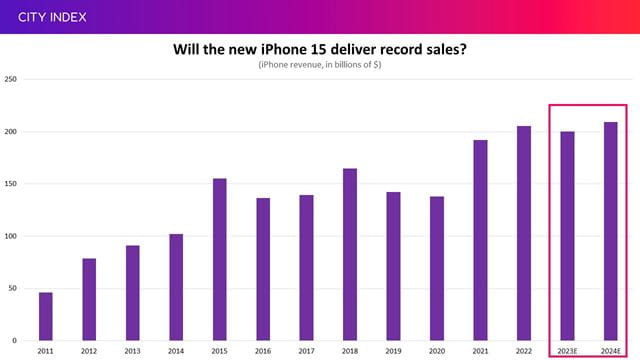
(Source: Company reports, with estimates from Bloomberg)
It is important to note that the anticipated growth in iPhone 15 sales is expected to come down to higher prices rather than volumes. There have been some reports that Apple is aiming to keep production of the new iPhone 15 broadly in-line with the iPhone 14, but for revenue to rise thanks to higher prices and higher demand for its pricier Pro versions.
The launch of the new iPhone is always a big event for Apple considering the device accounts for over half of its revenue! This has fallen in recent years considering the iPhone accounted for around 62% of revenue just five years ago. The decline reflects the contribution from new devices and its big push into digital services that now represent the fastest-growing part of the business.
Still, the iPhone remains equally as important considering Apple needs consumers to buy its hardware so it has more users to bring into its ecosystem. That is vital because it then has more consumers to sell everything from Apple TV and Music to its cloud and payment services to – all of which offer much juicier margins compared to flogging hardware.
Will China ban iPhones for public workers?
Apple shares have taken a beating ahead of the event following multiple reports that the Chinese government is banning citizens that work in the public sector, including any government-backed agencies or state-owned enterprises, from using an iPhone at work. That is part of a broader effort to purge foreign-made technology amid rising geopolitical tensions with the US, with both countries trying to stymie the others tech sectors.
That has not only sparked a selloff in Apple shares, but also of its array of suppliers like Skyworks, Qualcomm and TSMC as markets fear it could lead to lower demand. Other megacap tech stocks have also suffered as markets worry about the ability of US tech companies to operate in China, which remains at the centre of the growth story for many firms.
Apple iPhone: What would the impact be from China ban?
That has triggered fears that Apple’s sales in China, which accounts for 17% to 18% of company’s revenue, will come under pressure if consumers decide its easier to switch to a domestic brand rather than be forced to go to work without their phone, or have to buy two handsets, one for work and one for home.
Domestic competitors such as Huawei, which has just unveiled a new flagship phone boasting speedy data transfers and 5G speeds, are eagerly waiting to welcome any customers that abandon the iPhone. TF International Securities said this week that sales of the new phone have jumped in recent weeks.
The fears for Apple are understandable. The Chinese government has a bigger role in the economy than in most Western nations and the number of people employed in the public sector is significant. However, the intensity of the impact is now being debated. Bank of America has said the move could see Apple sell 5 million to 10 million fewer iPhones in China each year, while Wedbush is far more bullish and believes it could knock just 500,000 units off annual sales in the country. Based on estimates from the two brokers that it sells around 45 million to 50 million iPhones in China each year, those warnings suggests the ban could knock anywhere between 1% to 20% off its annual volumes in China.
Notably, there is some history that can provide some further insight. Apple posted lacklustre iPhone sales after releasing the iPhone XS and XR, which was followed by a slump in sales back in 2019 and 2020 (see the chart again above) and this was blamed on the US-China trade war and more protectionist measures in the latter. That shows that rising tensions could deliver a real blow.
On the other hand, China has been telling government workers and state-backed agencies and companies to replace their foreign-made tech with Chinese alternatives for years and we have, so far, not seen Apple suffer. In fact, Apple was one of the only smartphone makers that gained market share in the country during the second quarter of 2023, according to data from the IDC, although we can also see that Huawei is gaining ground and is by far the fastest-growing brand in the country.
Plus, Apple is a major part of the Chinese economy considering the majority of iPhones (and other devices) sold around the world are made in the country, employing hundreds of thousands of workers. That suggests China is more likely to try to find a balance between holding Apple back so home-grown competitors can gain ground without dealing such a blow that it hurts its own economy, which is already struggling since reopening after it abandoned its fight with Covid-19.
With that in mind, Apple has been aware it is too dependent on China for production for some time. Apple has already started expanding manufacturing in other countries such as India after realizing it has been too dependent on China for too long, which is now proving a risk given rising geopolitical tensions. India and other emerging markets are likely to become all the more important for both supply and demand for Apple going forward.
Where next for AAPL stock?
The introduction of the new iPhone is one of the biggest events of the year for Apple but it has not proven to be a major catalyst for the share price in the past. In fact, looking back at all the events spanning back to the launch of the first iPhone back in 2007, we can see Apple shares have lost ground during the month of the event twice as many times as it has gained ground.
It could be argued that its past performance, twinned with the fresh concerns around China, means the outlook for September is geared toward the downside more than usual. The counter argument is that the news out of China is being overblown and has provided an opportunity to buy what is proving to be a large dip ahead of the event.
Apple shares stormed higher for the first seven months of 2023, pushing the stock to new all-time highs, but we have seen it drop since the start of August amid a broader pullback in tech stocks. The recent fall caused by the news out of China means Apple is on course to suffer its sharpest monthly fall of 2023 in September. Looking at the monthly chart, there is evidence that Apple has already tested the support zone between $177.50 and $172, which had proven to be a zone of resistance in 2022.
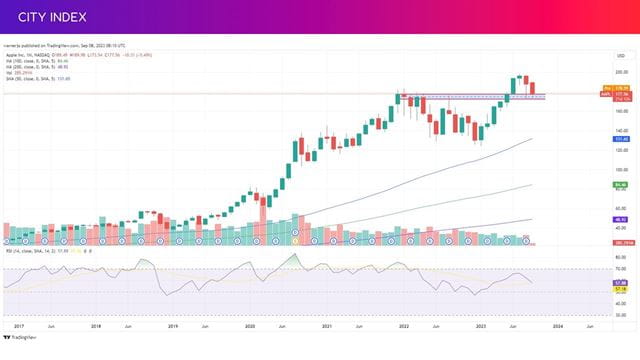
That is also reinforced by the rising channel that can be seen on the weekly chart. The long lower wick seen this week shows buyers have returned after it slipped below the supportive trendline and suggests upside from here. This suggests the stock could sink to as low as $173.50 before finding support.
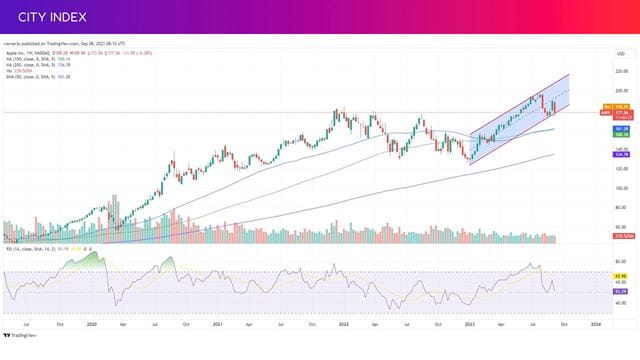
The daily chart suggests the stock could sink to as low as $170.50 before finding some support, so this may prove to be the floor should it remain under pressure. On the upside, the immediate goal is to return back above $191.50 to close the gap that was created when it lost ground in wake of its latest earnings report just over a month ago.
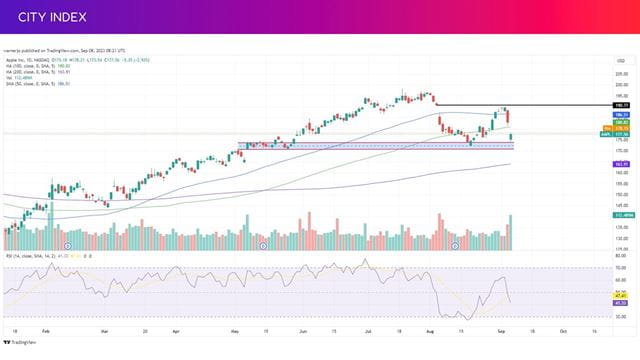
Nasdaq 100 forecast: Where next?
Apple is the single biggest company in the Nasdaq 100 with a weighting of 11.4%, making it highly influential on how the tech-heavy index performs.
The correction we saw begin in late July took the index to its lowest level in two months at 14,590 before it started to rebound. Notably, this is in-line with the 100-day moving average and reinforces the idea it can continue providing support if the index remains under pressure. This may be tested again if we see it drop back below the 50-day sma.
We have since seen it climb as high as 15,630 before running into some resistance. It is currently wedged between the 20-day and 50-day moving averages. Reclaiming the 20-day sma is the immediate job before it can look to test that resistance again and try to set a new September-high.
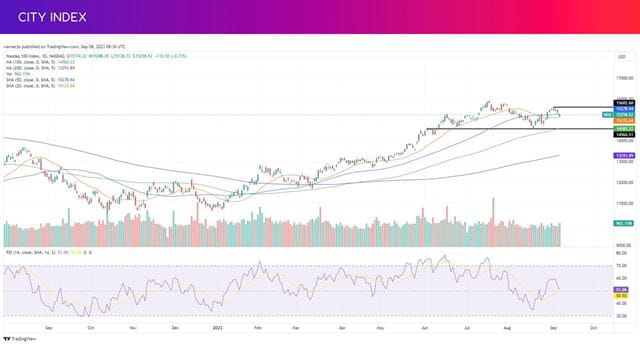
How to trade Apple stock
You can trade Apple shares and the Nasdaq 100 with City Index in just four easy steps:
- Open a City Index account, or log-in if you’re already a customer.
- Search for the stock or index you want in our award-winning platform
- Choose your position and size, and your stop and limit levels
- Place the trade
Or you can practice trading risk-free by signing up for our Demo Trading Account.





